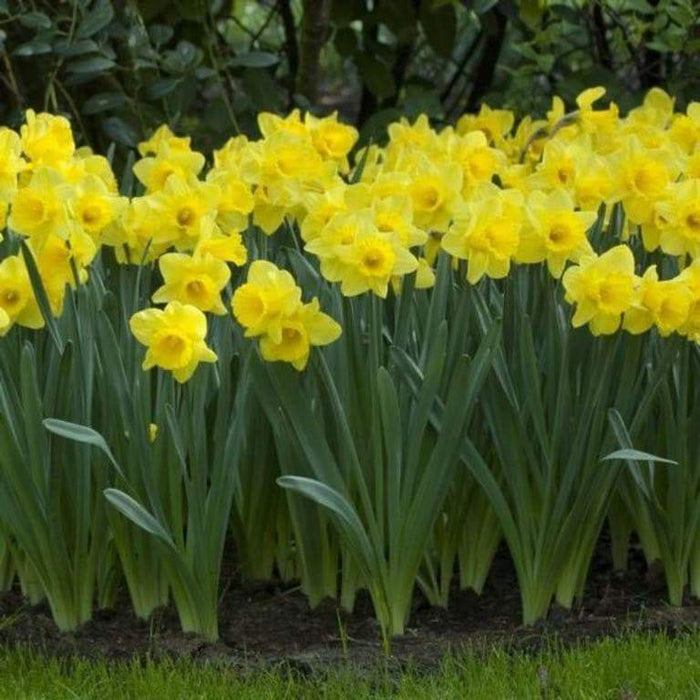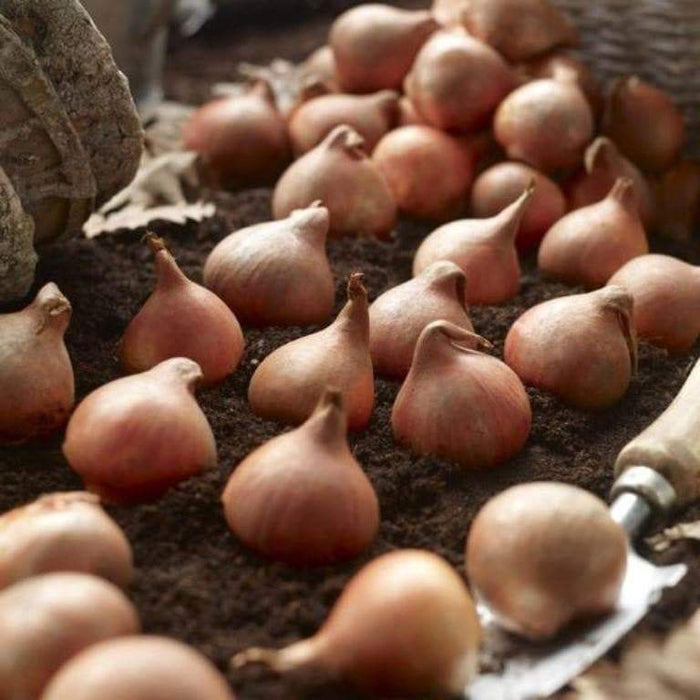
Daffodil Bulbs ,Trumpet yellow,Fall Planting
Original price
$ 10.85
-
Original price
$ 30.64
Original price
$ 10.85
$ 10.85
-
$ 30.64
Current price
$ 10.85
Most orders are processed by the next day
Select your desired size and/or color from the available options.
Narcissus Unsurpassable
This classic daffodil is bright golden yellow from top to bottom. It has an extra-large, widely flared trumpet and is one of the earliest daffodils to bloom each spring. Unsurpassible is a strong grower and excellent choice for naturalizing. Performs well in both warm and cold climates.
Find a location where the soil drains well. If there are still water puddles 5-6 hours after a hard rain, scout out another site. Or amend the soil with the addition of organic material to raise the level 2-3" to improve the drainage. Peat moss, compost, ground bark or decomposed manure all work well and are widely available. Daffodils will not thrive in water logged soils.
Site your daffs where they will receive sun for all or most of the day.
Dig holes and plant the bulbs with their pointed tops 4-7â below the soil surface with smaller bulbs placed more shallowly than larger ones. Allow 4 to 5 bulbs per square foot. Plant September through December; daffodils are tough and can be planted in 100 degree or 40 degree soil. Plant with the pointy side of the bulb facing upwards.
After planting, water daffodils well to settle the soil around the bulbs. Roots will form in the autumn. In warm regions some foiliage may also develop in the fall on select varieties. Buds and flowers are produced in the spring.
When in bloom, feel free to cut daffodil flowers for bouquets. This will not hurt the plants. One caution: daffodil sap contains a chemical that causes other flowers in the same vase to wilt. This is why you don't see daffodils mixed with other spring flowers in arrangements.
After blooming has finished for the season leave the foliage in place; don't cut it off. The leaves will gather sunlight, create food through photosynthesis and strengthen the bulbs for the future. Water as needed during active growth periods; about 1" of moisture per week is a good estimate.
By late spring or early summer the leaves will yellow and die back as the plants slip into dormancy. Foliage many be removed at this point. Your daffodils will rest for a few months before beginning the next growing cycle.
Pots, Barrels, Tubs & Urns
Find a large container and fill it with good quality, well-drained soil. Almost any commercially available potting medium will work fine. Make sure there are adequate drainage holes; daffodil bulbs must never sit in water logged soil or they will rot.
Site your daffs where they will receive sun for all or most of the day.
Plant the bulbs with their pointed tops 4-7â below the soil surface with smaller bulbs placed more shallowly than larger ones. Allow 6 to 8 bulbs per square foot. Plant September through December; daffodils are tough and can be planted in 100 degree or 40 degree soil. Plant with the pointy side of the bulb facing upwards.
After planting, water daffodils well to settle the soil around the bulbs. Roots will form in the autumn. In warm regions some foiliage may also develop in the fall on select varieties. Buds and flowers are produced in the spring.
When in bloom, feel free to cut daffodil flowers for bouquets. This will not hurt the plants. One caution: daffodil sap contains a chemical that causes other flowers in the same vase to wilt. This is why you don't see daffodils mixed with other spring flowers in arrangements.
After blooming has finished for the season leave the foliage in place; don't cut it off. The leaves will gather sunlight, create food through photosynthesis and strengthen the bulbs for the future. Water as needed during active growth periods; about 1" of moisture per week is a good estimate.
By late spring or early summer the leaves will yellow and die back as the plants slip into dormancy. Foliage many be removed at this point. Your daffodils will rest for a few months before beginning the next growing cycle.
Note: For container plantings in zone 6 and colder, we recommend overwintering pots in an unheated garage. This helps mitigate the effects of both very cold nights and the big temperature swings that can come with sunny winter days and bitter nights. Pull the pots outside in late February or March and watch for daffodil sprouts to appear.
We have a wide variety of Organic, Heirloom, Rare,Exoctic, Open-pollinated & NON GMO ,Vegetable, Herb, Fruit, and Flower Seeds for sale.
Select your desired size and color from the available option
This classic daffodil is bright golden yellow from top to bottom. It has an extra-large, widely flared trumpet and is one of the earliest daffodils to bloom each spring. Unsurpassible is a strong grower and excellent choice for naturalizing. Performs well in both warm and cold climates.
- Undemanding and Reliable
- Deer Won't Eat
- Good for Naturalizing
Find a location where the soil drains well. If there are still water puddles 5-6 hours after a hard rain, scout out another site. Or amend the soil with the addition of organic material to raise the level 2-3" to improve the drainage. Peat moss, compost, ground bark or decomposed manure all work well and are widely available. Daffodils will not thrive in water logged soils.
Site your daffs where they will receive sun for all or most of the day.
Dig holes and plant the bulbs with their pointed tops 4-7â below the soil surface with smaller bulbs placed more shallowly than larger ones. Allow 4 to 5 bulbs per square foot. Plant September through December; daffodils are tough and can be planted in 100 degree or 40 degree soil. Plant with the pointy side of the bulb facing upwards.
After planting, water daffodils well to settle the soil around the bulbs. Roots will form in the autumn. In warm regions some foiliage may also develop in the fall on select varieties. Buds and flowers are produced in the spring.
When in bloom, feel free to cut daffodil flowers for bouquets. This will not hurt the plants. One caution: daffodil sap contains a chemical that causes other flowers in the same vase to wilt. This is why you don't see daffodils mixed with other spring flowers in arrangements.
After blooming has finished for the season leave the foliage in place; don't cut it off. The leaves will gather sunlight, create food through photosynthesis and strengthen the bulbs for the future. Water as needed during active growth periods; about 1" of moisture per week is a good estimate.
By late spring or early summer the leaves will yellow and die back as the plants slip into dormancy. Foliage many be removed at this point. Your daffodils will rest for a few months before beginning the next growing cycle.
Pots, Barrels, Tubs & Urns
Find a large container and fill it with good quality, well-drained soil. Almost any commercially available potting medium will work fine. Make sure there are adequate drainage holes; daffodil bulbs must never sit in water logged soil or they will rot.
Site your daffs where they will receive sun for all or most of the day.
Plant the bulbs with their pointed tops 4-7â below the soil surface with smaller bulbs placed more shallowly than larger ones. Allow 6 to 8 bulbs per square foot. Plant September through December; daffodils are tough and can be planted in 100 degree or 40 degree soil. Plant with the pointy side of the bulb facing upwards.
After planting, water daffodils well to settle the soil around the bulbs. Roots will form in the autumn. In warm regions some foiliage may also develop in the fall on select varieties. Buds and flowers are produced in the spring.
When in bloom, feel free to cut daffodil flowers for bouquets. This will not hurt the plants. One caution: daffodil sap contains a chemical that causes other flowers in the same vase to wilt. This is why you don't see daffodils mixed with other spring flowers in arrangements.
After blooming has finished for the season leave the foliage in place; don't cut it off. The leaves will gather sunlight, create food through photosynthesis and strengthen the bulbs for the future. Water as needed during active growth periods; about 1" of moisture per week is a good estimate.
By late spring or early summer the leaves will yellow and die back as the plants slip into dormancy. Foliage many be removed at this point. Your daffodils will rest for a few months before beginning the next growing cycle.
Note: For container plantings in zone 6 and colder, we recommend overwintering pots in an unheated garage. This helps mitigate the effects of both very cold nights and the big temperature swings that can come with sunny winter days and bitter nights. Pull the pots outside in late February or March and watch for daffodil sprouts to appear.
We have a wide variety of Organic, Heirloom, Rare,Exoctic, Open-pollinated & NON GMO ,Vegetable, Herb, Fruit, and Flower Seeds for sale.
Select your desired size and color from the available option
LET OUR CUSTOMER SPEAK FOR US

![[Seeds] - Caribbeangardenseed](http://caribbeangardenseed.com/cdn/shop/files/gift-card-gift-card-1_1024x1024_dfa857db-9150-4315-a362-7f0bb3fb9c47_60x28.png?v=1703978838)



